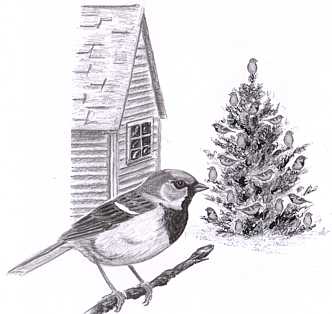
Dear Bird Folks:
I’m convinced that every kind of brown bird known to mankind is eating from my feeder. They descend in flocks of 20-30 birds, clean out the feeder and then hide out in the nearby prickly bush. My bird guide makes me think they could be sparrows, but none of them look like the ones in the book. What kind do you think they are?
-Wanda Ring, Brewster
Yo Ms Ring,
Let me say right now that we are not going to have any more of this fake cutesy name stuff. “Wanda Ring”? Right, who are you married to, “Ken Fused”? Too many names like that are probably what killed Dear Abbey. (She is dead, isn’t she?) Lucky for you that I’ve been getting this same question a lot lately. There’s a person in Sandwich (no, the person’s name is not “Sandy Witch”) in the same situation, lots of little brown birds emptying the feeder everyday. Sounds like the same birds to me.
You both have House Sparrows, lots and lots of House Sparrows. The reason why you couldn’t find this sparrow in your bird book is because these sparrows aren’t from this continent. They are considered “Old World” sparrows. (By Old World I mean Europe and Africa, not Sarasota, Florida.) Like most of us, House Sparrows are imports from somewhere else. Our native sparrows, such as Song Sparrows and Chipping Sparrows, aren’t related to House Sparrows and thus they aren’t pictured in the book together. But believe me they are in there. Flip open your index and you’ll find the House Sparrow listed in another section of the book, usually way in the back.
The male House Sparrows are well marked with a gray cap and a black bib. The females and the young birds on the other hand, are basic dull, generic brown birds. Their dullness and lack of field marks makes them difficult to identify. The best way to identify them is from their behavior, which you have done a very good job of describing.
House Sparrows travel in raucous flocks. They are like the large ethnic family down the street who are always fighting. They can’t do a thing without each other, yet they seem to be at each other throats day in and day out. House Sparrows eat, roost and fly in large flocks, while screaming in each others faces the whole time. At night, House Sparrows form huge noisy roosting flocks. During the day they form smaller flocks in search for food.
Everything you said Wanda is correct, these sparrows can strip a feeder clean in minutes. If they get spooked by a predator, they all dart into a nearby bush and finally shut up to avoid being eaten. Once the danger passes, they all leave the bush and start chowing at the feeder again. A few of our native sparrows will visit our feeders too, but they are a lot quieter and are rarely in large flocks.
The fact that you have 20-30 of these sparrows doesn’t surprise me, since the North American population is estimated to be in excess of 150,000,000 of them. That is quite a few birds considering that they didn’t even exist in this country until just before the Civil War.
As their name might indicate, House Sparrows flourish near our homes. Their population growth mirrors the expansion of our farms, towns and cities. Their instant growth hasn’t come without a price though. Many native birds have been displaced or eliminated by the more aggressive House Sparrows.
Because of their aggressiveness and their effects on native birds, many people don’t like House Sparrows. I really can’t blame them. Yet, if it wasn’t for these sparrows, many city yards and parks might be totally devoid of bird life. House Sparrows have taken advantage of human encroachment and have adapted very well to the building, trash and concrete that we bring with us.
House Sparrows don’t like to be far away from people. If you want to avoid them you are going to have to pack up and move deep into the woods. Of course when you do that you’ll be creating new habitat for House Sparrows. So maybe you should stay where you are Wanda; you and Ken Fused.